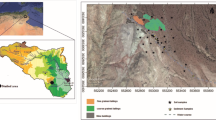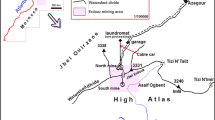Abstract
Purpose
The aim of this study was to evaluate (i) the ability of two Technosols, prepared with gossan or sulfide-rich wastes plus mixtures of organic/inorganic amendments, to improve the characteristics of the wastes by the analysis of the variation of elemental concentrations in their simulated leachates, and (ii) the potential environmental risk of these Technosols evaluated through the concentrations of the elements leached from the tailings containing the two wastes, considering their mass in the São Domingos mine.
Materials and methods
Composite samples of two São Domingos mining wastes (gossan wastes—GW; sulfide-rich wastes—SW) were collected. Amendment mixtures, containing different organic/inorganic wastes (from green agriculture, distillation of Ceratonia siliqua and Arbutus unedo fruits, and limestone quarry), were applied at 12, 30, and 60 g/kg. Two sets of microcosm assays were performed under controlled conditions in greenhouse and monitored during 7 and 13 months for GW and SW, respectively. Materials from each pot/treatment (<5 cm of depth) were collected after 1, 4, 7, and 13 months of incubation and used to obtain simulated leachates (DIN extraction). The analytical parameters evaluated in the leachates were pH, electrical conductivity, and element concentrations using flame atomic absorption spectrometry for cations and graphite furnace atomic absorption spectrometry, ionic chromatography, and UV-VIS for elements that normally occur as anions in aqueous solution.
Results and discussion
Simulated leachates from SW had lower pH and higher concentrations of potentially hazardous elements than leachates from GW. The concentrations of As in leachates from GW-Technosols were higher than those in leachates from GW-control but <0.6 mg/kg. In GW-Technosols leachates, the pH and the concentrations of some nutrients (e.g., Ca and phosphates) also increased when compared to the control. In the SW-Technosols, the pH of the leachates increased only in the first month as long as limestone was present. In these leachates, a general decrease of the concentrations of some elements was observed (e.g., As, sulfate, Fe, Pb), especially in the first month. A clear influence of the dose and type of amendments was not observed during the experimental time span for both wastes.
Conclusions
The concentrations of elements like Al, Ca, Fe, and Pb in the leachates are controlled by both the pH of the solutions and the concentrations of phosphates and sulfates. The extensive mass of the studied mine wastes contribute to the release to the neighboring environment of considerable amounts of potentially hazardous elements. The rehabilitation of the mine wastes by the conception of Technosols, especially with sulfide-rich wastes, can reduce significantly their environmental impact.






Similar content being viewed by others
References
Abreu MM, Tavares MT, Batista MJ (2008) Potential use of Erica andevalensis and Erica australis in phytoremediation of sulphide mine environments: São Domingos, Portugal. J Geochem Explor 96:210–222
Abreu MM, Batista MJ, Magalhães MCF, Matos JX (2010) Acid mine drainage in the Portuguese Iberian Pyrite Belt. In: Brock CR (ed) Mine drainage and related problems. Nova Science Publishers, Inc., New York, pp. 71–118
Abreu MM, Santos ES, Ferreira M, Magalhães MCF (2012) Cistus salviifolius a promising species for mine wastes remediation. J Geochem Explor 113:86–93
Adriano DC, Wenzel WW, Vangronsveld J, Bolan NS (2004) Role of assisted natural attenuation in environmental cleanup. Geoderma 122:121–142
Alvarenga P, Palma P, Gonçalves AP, Fernandes RM, de Varennes A, Vallini G, Duarte E, Cunha-Queda AC (2009) Organic residues as immobilizing agents in aided phytostabilization: (II) effects on soil biochemical and ecotoxicological characteristics. Chemosphere 74:1301–1308
Álvarez-Valero AM, Pérez-López R, Matos J, Capitán MA, Nieto JM, Sáez R, Delgado J, Caraballo M (2008) Potential environmental impact at São Domingos mining district (Iberian Pyrite Belt, SW Iberian peninsula): evidence from a chemical and mineralogical characterization. Environ Geol 55(8):1797–1809
Chezom D, Chimi K, Choden S, Wangmo T, Gupta SK (2013) Comparative study of different leaching procedures. Int J Engine Res General Sci 1(2):5
Da Pelo S, Musu E, Cidu R, Frau F, Lattanzi P (2009) Release of toxic elements from rocks and mine wastes at the Furtei gold mine (Sardinia, Italy). J Geochem Explor 100:142–152
DIN 38414-S4 (1984) Schlamm und Sedimente,Bestimmung der Eluierbarkeit mit Wasser. DIN Deutsches Institut für Normung, Berlin
Fällman AM, Aurell B (1996) Leaching tests for environmental assessment of inorganic substances in wastes, Sweden. Sci Total Environ 178:71–84
Forsberg LS, Gustafsson JP, Kleja DB, Ledin S (2008) Leaching of metals from oxidising sulphide mine tailings with and without sewage sludge application. Water Air Soil Pollut 194:331–341
Gomes JFP, Pinto CG (2006) Leaching of heavy metals from steelmaking slags. Rev Metal 42(6):409–416
González V, Moral GFD, Simón M (2012) Effectiveness of amendments on the spread and phytotoxicity of contaminants in metal–arsenic polluted soil. J Hazard Mater 205-206:72–80
Hodson ME, Valsami-Jones E, Cotter-Howells JD, Dubbin WE, Kemp AJ, Thornton I, Warren A (2001) Effect of bone meal (calcium phosphate) amendments on metal release from contaminated soils—a leaching column study. Environ Pollut 112:233–243
Ioannidis TA, Zouboulis AI (2005) Hazardous industrial waste stabilization using inorganic phosphates: investigation of possible mechanisms. Pure Appl Chem 77(10):1737–1752
Kabata-Pendias A (2011) Trace Elements in Soils and Plants, 4th edition. CRC Press. Taylor &Francis Group, Boca Raton
Kocasoy G, Murat ZM (2009) Comparison of the characteristics of the leachate and the eluates obtained by different methods. J Environ Sci Health 44(6):605–614
Kumpiene J, Lagerkvist A, Maurice C (2008) Stabilization of As, Cr, Cu, Pb and Zn in soil using amendments—a review. Waste Manag 28:215–225
Macías F (2004) Recuperación de suelos degradados, reutilización de resíduos y secuestro de carbono. Una alternativa integral de mejora de la calidad ambiental Recur Rurais 1:49–56
Macías F, Macías-García F, Nieto C, Verde JR, Pérez C, Bao M, Camps-Arbestain M (2011) Gestión de residuos y cambio climático. In: Mosquera MEL, Osés MJS (eds) Gestión de residuos orgánicos de uso agrícola. Servizo de Publicacións e Intercambio Científico de la Universidad de Santiago de Compostela, Santiago de Compostela
Matos JX, Martins LP (2006) Reabilitação Ambiental de Áreas Mineiras do sector Português da Faixa Piritosa Ibérica: Estado da Arte e Prespectivas Futuras. Bol Geol Min Esp 117:289–304
Perera AS, Al-Tabaa A, Rid JM, Stegmemann JA, Shi C (2005) Testing and performance criteria for stabilized/solidified wastes forms. In: Spence RD, Shi C (eds) Stabilization and solidification of hazardous, radioactive, and mixed wastes. CRC Press, Boca Raton
Pérez-López R, Álvarez-Valero AM, Nieto JM, Sáez R, Matos JX (2008) Use of sequential extraction procedure for assessing the environmental impact at regional scale of the São Domingos mine (Iberian Pyrite Belt). Appl Geochem 23:3452–3463
Quental L, Bourguignon A, Sousa AJ, Batista MJ, Brito MG, Tavares T, Abreu MM, Vairinho M, Cottard F (2002) MINEO Southern Europe environment test site. Contamination impact mapping and modelling - Final Report. Assessing and Monitoring the environmental impact of mining activities in Europe using advanced Earth Observation Techniques (MINEO) 5yth FP-IST-1999-10337
Quental LE, Sousa AJ, Marsh S, Brito G, Abreu MM (2013) Identification of materials related to acid mine drainage using HYMAPTM at S. Domingos mine. SE Portugal Int J Remote Sens 34(6):1928–1948
Reis AP, Ferreira da Silva E, Cardoso Fonseca E, Patinha C, Barrosinho C, Matos J (2012) Environmental assessment of the Caveira abandoned mine (southern Portugal): part 1: characterization of metal contaminated soil. Soil Sediment Contam Int J 21(2):227–254
Sánchez-España J, Pamo EL, Santofimia E, Aduvire O, Reyes J, Barettino D (2005) Acid mine drainage in the Iberian Pyrite Belt (Odiel river watershed, Huelva, SW Spain): geochemistry, mineralogy and environmental implications. Appl Geochem 20:1320–1356
Sánchez-España J, Toril GE, Pamo EL, Amils R, Ercilla MD, Pastor ES, San Martín-Úriz P (2008) Biogeochemistry of hyperacid and ultraconcentrated pyrite leachate in san Telmo mine (Iberian Pyrte Belt, Spain). Water Air Soil Pollut 194:243–257
Santos ES, Abreu MM, Nabais C, Magalhães MCF (2012) Trace element distribution in soils developed on gossan mine wastes and Cistus ladanifer L. tolerance and bioaccumulation. J Geochem Explor 123:45–51
Santos ES, Abreu MM, de Varennes A, Macías F, Leitão S, Cerejeira MJ (2013) Evaluation of chemical parameters and ecotoxicity of a soil developed on gossan following application of polyacrylates and growth of Spergularia purpurea. Sci Total Environ 461-462:360–370
Santos ES, Magalhães MCF, Abreu MM, Macías F (2014a) Effects of organic/inorganic amendments on trace elements dispersion by leachates from sulfide-containing tailings of the São Domingos mine. Portugal Time evaluation Geoderma 226-227:188–203
Santos ES, Abreu MM, Macías F, de Varennes A (2014b) Improvement of chemical and biological properties of gossan mine wastes following application of amendments and growth of Cistus ladanifer L. J Geochem Explor 147:173–181
Santos ES, Abreu MM, Macías F, de Varennes A (2016) Chemical quality of leachates and enzimatic activities in Technosols with gossan and sulfide wastes from the São Domingos mine. J Soil Sediments 16:1366–1382
Sparks DL (1995) Environmental soil chemistry. Academic Press, London
USEPA – United States Environmental Protection Agency (1979) Methods for chemical analysis of water and waste. Office of Research and Development, US Environmental Protection Agency, method 365.2, Cincinatti, Ohio
Yao FX, Macías F, Santesteban A, Virgel S, Blanco F, Jiang X, Camps Arbestain M (2009) Influence of the acid buffering capacity of different types of Technosols on the chemistry of their leachates. Chemosphere 74:250–258
Zhang S, Li W, Shan XQ, Lu A, Zhou P (2005) Effects of low molecular weight organic anions on the release of arsenite and arsenate from a contaminated soil. Water Air Soil Pollut 167(1–4):111–122
Acknowledgments
The authors would like to thank the following: Madre Fruta (Hubel Group) for providing the agriculture wastes and rockwool and Mr. José G. L. Sequeira for the wastes from the liquor distillery (Adega Aldeia do Talurdo); Carmen Pérez, David Romero, and José Correia for technical support; and the Fundação para a Ciência e a Tecnologia (FCT) for the PhD grant (SFRH/BD/80198/2011). This work was developed in the scope of the projects: LEAF - Instituto Superior de Agronomia, Universidade de Lisboa (FCT-UID/AGR/04129/2013) and CICECO - Aveiro Institute of Materials (FCT UID /CTM /50011/2013).
Author information
Authors and Affiliations
Corresponding author
Additional information
Responsible editor: Jaume Bech
Rights and permissions
About this article
Cite this article
Santos, E.S., Abreu, M.M., Macías, F. et al. Potential environmental impact of technosols composed of gossan and sulfide-rich wastes from São Domingos mine: assay of simulated leaching. J Soils Sediments 17, 1369–1383 (2017). https://doi.org/10.1007/s11368-016-1518-y
Received:
Accepted:
Published:
Issue Date:
DOI: https://doi.org/10.1007/s11368-016-1518-y




